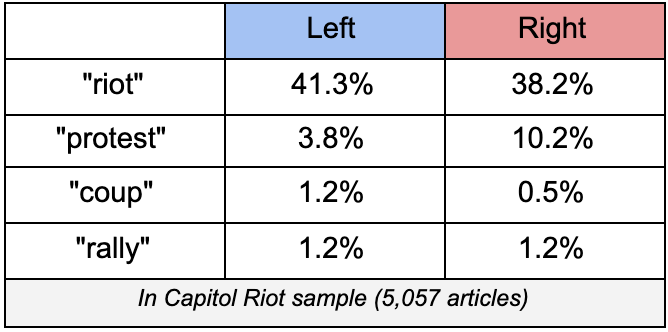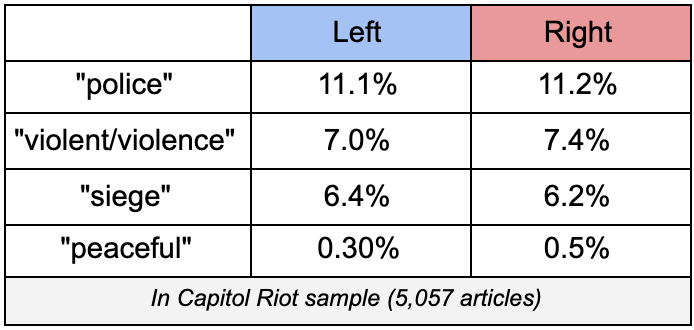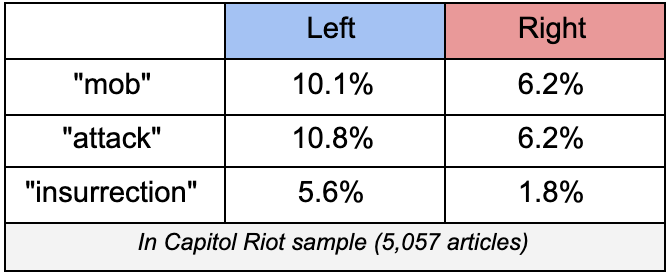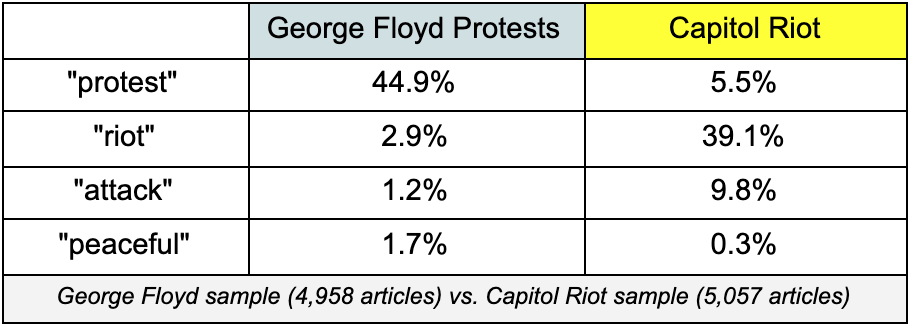The words media outlets use to describe events play a large role in shaping public perception of those events. As January 6 unfolded on Capitol Hill, there was a rapid shift in language, from “protesters,” “supporters,” and “rally” to “siege,” “rioters,” and “insurrection.” These choices — on the day of the attack and in its aftermath — matched the descent of a seemingly peaceful protest into a violent and dangerous attack on the seat of the U.S. federal government.
Using 5,057 article titles about the Capitol Riot from 398 sources across the political spectrum, The Factual examined how the events and aftermath of January 6 are most commonly described in U.S. and global media. This includes the differences in language between left- and right-leaning publications, as well as how the terminology used compares to our analysis of coverage of the George Floyd protests this summer.
Note: An article’s title is not always a perfect representation of its content, but titles matter deeply in shaping readers’ perceptions of what media outlets are writing, whether there are contrasting views between political parties, and whether/how an event matters — especially in the social media era.
Please check your email for instructions to ensure that the newsletter arrives in your inbox tomorrow.
The Words Used to Describe January 6
The U.S. media ecosystem includes hundreds of outlets, reflecting the myriad ideologies, political alignments, and niche areas of interest that motivate the American populace. They help define the core issues that drive American political and social discourse, and the words they use are central to how Americans understand current events. It should be no surprise, then, that the ways the media talks about the events of January 6 are key to building a consensus about what happened and unpacking how such an event may impact the U.S. going forward.
While there are some clear differences in the way the left and right talk about the Capitol Riot, instances of agreement are a good place to start. For example, there seems to be broad consensus that January 6 constituted a riot, not something less intense like a protest or something more intense like a coup. Around 40% of article titles from both left-leaning (41.3%) and right-leaning (38.2%) outlets in our sample used the term “riot.” While the term “protest” was twice as likely to appear in titles from the right, the term appeared in just 5.5% of all articles, demonstrating that the term was inadequate to capture the day’s events. Meanwhile, “rally,” the purported nature of the pro-Trump gatherings prior to the riot, appeared in just 1.2% of titles.

Other words were used with roughly similar frequency regardless of the publisher’s political bias. Reporting from across the political spectrum mentions “violent” or “violence,” “siege,” and “police” about the same amount, reflecting at least a partial shared understanding of the lengthy clashes between police and the numerous rioters. Further, just 16 of the 5,057 article titles included the word “peaceful.”

A third of article titles on the left (33%) and a quarter of those on the right (26%) mention Trump, highlighting a shared understanding of his proximity to the events of January 6. However, there are some clear differences in usage. While many of the article titles from the right are ambiguous about Trump’s role, articles from the left directly accentuate his connection to the riot, slow condemnation of the violence, and culpability in the aftermath.
Language also varied when discussing the behavior of the rioters. Article titles on the left were more likely to mention “mob,” “attack,” and “insurrection,” zeroing in on how pro-Trump supporters engaged in violent action against DC Capitol Police and invaded the Capitol building.

Overall, these differences in terminology reflect the political landscape in the aftermath of January 6 in two ways: (1) a central consensus clearly labels the event as a riot and shares some broad interpretations of the day’s events, and (2) on average, left-leaning interpretations accentuate the violent, seditious nature of events while right-leaning publications take a softer tone.
How These Words Compare to the George Floyd Protests
Just as many saw fundamentally different responses to the George Floyd protests and the Capitol Riot, The Factual’s data reveals a few differences in the way these events were described in the media. (This analysis uses an earlier study we conducted based on a similarly sized dataset of 4,958 article titles from the 10 days following George Floyd’s killing.)
Most prominently, the George Floyd protests were far more likely to be described using the word “protest” (44.9%) and far less likely to involve “riot” (2.9%) than the Capitol Riot. The events on Capitol Hill were 10 times as likely to be described as an “attack,” while the George Floyd protests were 5 times more likely to be described as “peaceful.” This makes intuitive sense since the George Floyd protests encompass hundreds of separate events and were 93% peaceful. The Capitol Riot, on the other hand, refers specifically to a single event where numerous violent incidents took place. Importantly, however, this highlights that efforts to equate the Capitol Riot with the George Floyd protests — for whatever purpose — are of limited use.

There is also generally more agreement between left- and right-leaning outlets about what terminology to use to describe the Capitol Riot. Our analysis of coverage of the George Floyd protests showed larger divergences between left and right, for example, in terms of usage of “protest” or “riot”:
[A]rticles from outlets on the right featured “riot,” “riots,” or “rioting” in 12.9% of all article titles, while only 2.6% of article titles on the left featured those terms. Similarly, article titles on the right were twice as likely (8.1%) to use some variation of the word “loot” than the left (3.8%). Conversely, articles on the left were 10% more likely (43.7%) to feature a variation of the term “protest” than those on the right (33.8%), and 7.8% of articles on the left featured the term “non-violent,” which didn’t appear in any article titles on the right.
Though Trump played a prominent role during the George Floyd protests, particularly relating to his use of federal forces like the National Guard, he was in retrospect a secondary player in the national upheaval over institutional racism and police brutality; he was mentioned in 9.4% of article titles from that period. By contrast, he was three times as likely to be mentioned in titles related to the Capitol Riot (31.1%). Conversely, the police were mentioned repeatedly during the George Floyd protests (40.5%), unsurprising given their centrality to the upheaval, but were mentioned with less frequency in relation to the Capitol Riot. Despite their varied interactions both fighting and assisting the rioters, “police” only appeared in 10.9% of all articles related to the events in DC.

A further way media coverage has differed is through the words that fail to appear in coverage of the events on Capitol Hill. For example, instances of looting during this summer’s protests were used by some to try to delegitimize the entire Black Lives Matter movement. In our sample about the George Floyd protests, “looting” — to “steal goods from (a place), typically during a war or riot” — was mentioned in 3.4% of article titles, slightly more than the 2.9% of articles that mentioned “riot.” By contrast, though 39.1% of article titles about January 6 included the word “riot” and even as assailants broke into the Capitol building, stole government property, and evidence was widely published of them doing so, there wasn’t a single mention of “looting” in the 5,057 article titles in our sample.

Please check your email for instructions to ensure that the newsletter arrives in your inbox tomorrow.
How Far Apart
Regardless of the words one uses to describe the political division in the U.S., it is apparent that there is some distance between the left and right on the future of the country, the optimal direction for policy, and especially how to think about the last four years. However, the words used to describe the Capitol Riot suggest more unity than one might expect, at least in terms of the media’s portrayal of what will likely be the most memorable day of the Trump administration. Media coverage from across the political spectrum is certainly in greater agreement about the character of events in DC than it was about the George Floyd protests this summer. If the desire is to rein in partisan division, coming to a set of common terms to describe the events of January 6 is a good start.
Appendix
This appendix shows each of the articles used to inform the findings of this article, as well as how the articles scored according to The Factual’s credibility algorithm. To learn more, read our How It Works page.

